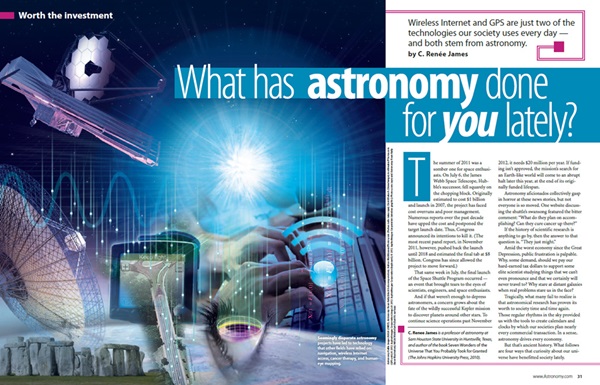In an era when baseball teams sell for $2 billion and consumers line up at Starbucks to purchase more than 8 million cups of premium-priced coffee every day, NASA struggles to secure adequate congressional funding. Currently, the space agency receives about half a penny from every tax dollar the federal government collects. For fiscal year 2013, this would amount to $17.7 billion, which is $59 million less than the agency received this year and the lowest amount since 1959 (as a percentage of the U.S. federal budget). Not only does this threaten the viability of existing programs, such as development of the James Webb Space Telescope — the successor to the aged Hubble Space Telescope — but also NASA’s long-term goal of launching its first test flight of a deep-space rocket and capsule in 2017, and the first crewed mission by 2021. This vehicle could eventually land a human on a distant asteroid or even Mars, helping the United States maintain its leadership role in exploring the cosmos.
But given the fiscal challenges closer to home, both the government and the public today question the value of funding space science. In response, Astronomy magazine commissioned C. Renée James, professor of astronomy at Sam Houston State University in Huntsville, Texas, to tackle this question: “What has astronomy done for you lately?” Her response appears in the May 2012 issue of Astronomy, on newsstands April 3.
In an article titled, appropriately, “What has astronomy done for you lately?” James details how four significant modern-day technologies trace their origins to the pioneering work of astronomers, physicists, and scientists in other disciplines. For example, her Astronomy magazine article explains how the search for the miniature black holes first theorized by Stephen Hawking in 1974 eventually led to the creation of the Fast Fourier Transform (FFT) chip in the mid-1990s. This FFT chip underpinned the development of wireless Internet access in 1999, which is the basis for today’s $80-billion wireless industry and expedites countless transactions via WiFi every day.
Another technology that today’s consumers rely upon is the Global Positioning System (GPS), which owes its genesis to Albert Einstein’s general theory of relativity, published in 1916. James’ article explains the connections that led from his theory to the GPS satellites that help millions of people worldwide easily find their destination and enhance the usefulness of a growing number of smartphone apps.
In addition, a modern cancer treatment and significant improvement in vision correction arose from scientific funding.
As astrophysicist Neil deGrasse Tyson, television personality and director of the American Museum of Natural History’s Hayden Planetarium in New York, stated March 7 during remarks he made to Congress about NASA’s proposed 2013 budget: “I say take it to a penny,” referring to the amount of every collected tax dollar the space agency receives, which would effectively double NASA’s budget.
Tyson added, “As goes the future of NASA, so too does the future of this nation.”










